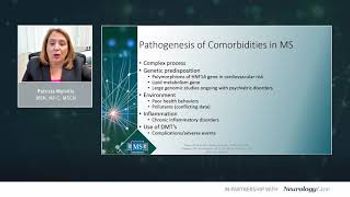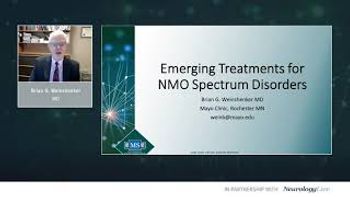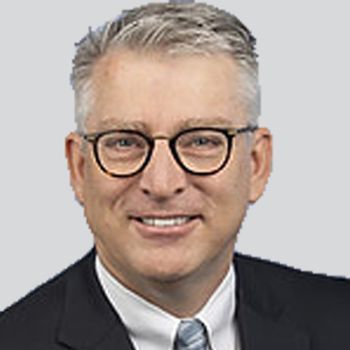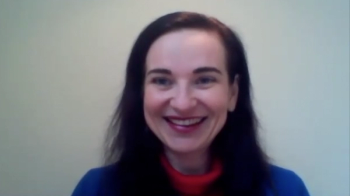
The Novartis agent showed benefit in patients who had multiple sclerosis both with and without relapses.

The Novartis agent showed benefit in patients who had multiple sclerosis both with and without relapses.

Patricia Melville, NP-C, MSCN, and Marijean Buhse, PhD, NP-C, MSCN, present their lecture titled, "Comorbidities and MS: Critical Thinking About DMTs and Vaccines" as part of the 2020 CMSC Virtual Annual Meeting.

Amy Sullivan, PsyD, ABPP, presents her lecture titled, "Science, Art, and Practice of Behavioral Medicine" as part of the 2020 CMSC Virtual Annual Meeting.

Brian Weinshenker, MD presents his lecture titled, "Neuromyelitis Optica Spectrum Disorders: Emerging Treatment Options" as part of the 2020 CMSC Virtual Annual Meeting.

Patricia Coyle, MD, delivers her lecture titled, "Progressive MS: Diagnosis, Clinical Course and Long-Term Management" as part of the 2020 CMSC Virtual Annual Meeting.

Evobrutinib, a highly selective BTK inhibitor for the treatment of relapsing multiple sclerosis, showed long-term safety and success in reducing annualized relapse rates.

The Genentech agent, which is approved for patients with relapsing-remitting multiple sclerosis, showed no new safety signals in a comparison between conventional and shorter infusion times.

Novartis’s anti-CD20 monoclonal antibody has been shown to increase the odds of patients with multiple sclerosis achieving no evidence of disease activity status by more than 3-fold in the first year and more than 8-fold in the second year.

The director of behavioral medicine at the Mellen Center for MS Treatment and Research at Cleveland Clinic detailed the need to incorporate interdisciplinary care and behavioral medicine in commonplace MS practice.

The director of the multiple sclerosis research unit at Ottawa Hospital discussed stem cell therapies being explored in multiple sclerosis, and which patients may be eligible for these treatments.

The study author, director of MedStar Georgetown Headache Center, and associate professor of neurology at MedStar Georgetown University Hospital discussed the findings of a pooled analysis of the ACHIEVE I and II studies of ubrogepant.

The chief of the Division of Neurology at Children’s Hospital of Philadelphia spoke to the need for clinical trial evidence and research for the pediatric MS population.

The director of the Headache Center of Southern California discussed the findings of the study, as well as what these data might suggest about how onabotulinumtoxinA fits into the shifting landscape of chronic migraine care.

The director of behavioral medicine at the Mellen Center for MS Treatment and Research at Cleveland Clinic discussed the importance of interdisciplinary care and ways it can be incorporated for patients with multiple sclerosis.

The neurologist at the Mellen Center for Multiple Sclerosis Treatment and Research at Cleveland Clinic discussed how the agent might fit into the treatment landscape if its sBLA is approved by the FDA later this year.

The new data further cemented the therapy’s consistent safety profile from previous studies as well as demonstrated a newfound durability in patients with later-onset spinal muscular atrophy.

The neurologist at Banner-University Medicine Neuroscience Institute offered his perspective on data from an open-label safety assessment of cannabidiol (Epidiolex) in the treatment of tuberous sclerosis complex.

The director of MedStar Georgetown Headache Center and associate professor of neurology at MedStar Georgetown University Hospital discussed the findings of an analysis from the ACHIEVE studies of ubrogepant.

Despite patients being off treatment for an average of 23 months, patients treated with Eisai’s BAN2401 remained amyloid PET negative in an open-label extension preliminary analysis.

The FDA-approved treatment was associated with a clinically meaningful delay in needing continuous ventilation among patients with Duchenne muscular dystrophy.

The headache specialist at UCSF discussed the findings of a retrospective assessment of the impact of the infusion rate of dihydroergotamine (DHE) on inpatient treatment outcomes.

The neurologist at Banner-University Medicine Neuroscience Institute discussed the findings of a study that suggest perampanel may improve insomnia by decreasing anxiety in patients with epilepsy.

Treatment with SK Life Science’s cenobamate showed higher responder rates than placebo, regardless of baseline seizure frequency or disease duration.

The director of the Stroke Center at Banner-University Medicine Neuroscience Institute spoke to the need for data like that from the TELECAST study and how the COVID-19 pandemic might push telestroke care forward.

The assistant professor of neurology at the University of Washington in St. Louis discussed the need for a systemic, multi-specialist approach to cerebral palsy and provided the main takeaways from her and her colleagues’ work.

The director of the Stroke Center at Banner-University Medicine Neuroscience Institute discussed how data from the TELECAST trial impact existing literature and the areas of improvement for the current use of telemedicine for stroke.

Treatment with fenfluramine was associated with greater seizure reduction, which in turn improved executive function over time in patients with Dravet syndrome.

The director of the Montefiore Headache Center discussed recent study findings on ubrogepant and offered insight into the possible future of the gepant class in migraine.

The assistant professor of neurology at the University of Washington in St. Louis detailed the ­­factors that may contribute to these inconsistencies in cerebral palsy diagnosis and what role neurologists should play.

Janssen’s S1P receptor modulator ponesimod showed its superiority to teriflunomide on annualized relapse rates, fatigue symptoms, MRI activity, brain atrophy, and NEDA-3 in patients with relapsing multiple sclerosis.